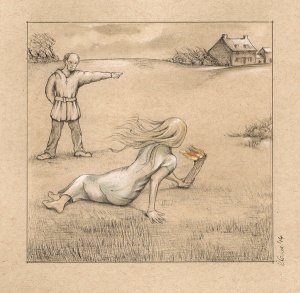With each song on the ‘Calendar’ album, one of the first tasks was to choose a perspective from which to write. Should we use a narrator’s voice, or should we present the story from the point of view of one of its characters? If so, which one? As these are historical songs, we often had the option of writing with the voice of a central character, but it was also possible to assign parts of the song to non-specific people from the period we were featuring.
Many of the songs include a shift of perspective, usually from the narrator in the verses to a character in the choruses. This fits the broad idea of verses being wordy, descriptive, scene-setting material and choruses being calls to action, pleas, or statements of purpose.
‘Here’s To Maybella’, our March song, contains such a shift. The verses tell the story in a factual and linear fashion, with the voice of a historian or folklorist, while the choruses celebrate Lady Maybella’s selflessness and determination in a more ‘pub singalong’ style, starting with “Here’s to Maybella!” – like a toast in song, and with the 3/4 rhythm accentuated by the metre of the lyrics to give those lines a hint of swaying tankards.
The story is essentially this:
In the late 13th century, the kindly Maybella was married to a miserly landowner called Roger De Tichborne. On her deathbed, she asked him to remember her by providing for the poor people of the parish each year. Roger handed her a burning log from the fire and declared that he would donate to the poor the yield from whatever land she could crawl around before the wind blew out the flame she was carrying. Maybella managed to cover 23 acres – an area still known as ‘The Crawls’. Over 700 years later, flour is still given to the residents of Tichborne by the parish priest every 25th March.
Lyrically, we wanted to tell the story of Maybella’s terminal ordeal, and celebrate her perseverence and commitment to her cause. Pretty obvious choices really. The lyrics are presented from a temporally ambiguous position; is it a contemporary folk song or could it have been written a couple of hundred years ago? I liked the idea of pretending it was old so I excluded any references that would locate its perspective in the present.
Musically it doesn’t do anything particularly strange. There are some unusual chords in the chorus, whose purpose can be illustrated by comparing them to their unenhanced counterparts as follows:
Under the lyrics “Here’s to Maybella, her courage and strength, she crawled on her knees the breadth and the length”, it could have gone:
D, – , Em, – , Bb, C, G, –
But instead I used:
D, – , Em11, – Bb6/C, C6/D, G^, –
The Em11 is 022232 – like an Em and a D simultaneously (the note of G is absent, but it is implied). This serves to keep hold of the D major from “Here’s to Maybella” while we raise the lower end of the chord to accompany the citation of her qualities as additional objects for our toast: “her courage and strength”. Since the Bb has a 6th, and a C in the bass, we could think of it as a C11 with no third. The same goes for the C6/D; it’s a D11(no 3rd). They’re fingered x33333 and x55555 respectively. The G^ is played 3x443x with a decorative figure that includes the open top string – a sixth, which I often include when voicing a G^ this way.
I’m sure you’ll agree there’s much more depth in these extended chords. I’m not opposed to the use of a handful of primary triads; many great pop songs have required nothing else from their guitar parts – and you’ll see in subsequent articles that ‘Calendar’ features a couple of three-chord numbers – but more atmospheric songs require a mood that is helped along by some less common harmonies.
The verse uses fairly standard chords, but at its end, just before the chorus comes, there’s a musical analogue to the wavy effect that was used on TV in the 70s to indicate the shift between reality and a dream or a memory – and here it heralds the change of perspective from narrator to singing celebrant. It’s a simple trick on the guitar: over an A7, a little two-part harmony is played which includes an augmented 5th for a touch of tension, and each time it occurs in the song, that movement is emphasised more strongly by the strings and woodwind. The verse/chorus junction would work fine without any of this, but the brief pause and a splash of harmonic ambiguity lend a little drama to the retelling of this moving – and quite tragic – tale.
To hear samples of all the songs on the ‘Calendar’ album, go to The Straw Horses website.

